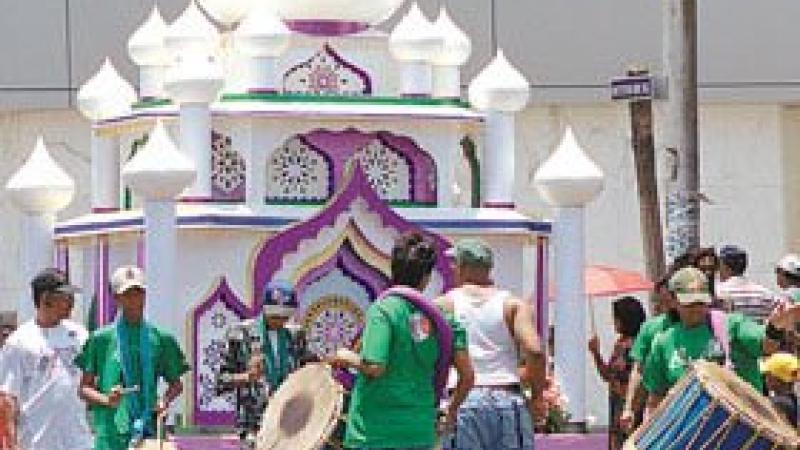
{{The theatre of Hosay in St. James and Cedros, Trinidad & Tobago.}}
{{By Dr. Kumar Mahabir}}
Hosay was observed in the form of a street procession in St. James and Cedros, TRINIDAD, on Friday night (January 18, 2008). A day-time procession took place on Saturday January 19, 2008
The term Hosay (Hose or Hosea) is a corruption of the name {Husain/Husayn}, the grandson of Prophet Mohammed. He was a soldier and priest [imam] who was killed in de–fence of Islamic principles by the corrupt Yazid army in the battle of Karbala (Iraq) on the tenth day of the Muharram (first month of the Muslim year) in 680 A.D.
This day is marked by all Muslims as the day when the first rain fell, when Adam and Eve were created; when the ninth heaven was created, and when the divine mission was granted to the spirits of the ten thousand prophets. But of special significance to the{ Shi’ah/Shi’ite} Muslims, it is a time of profound mourning for the martyrdom of Husain.
The observances in commemoration of his death vary with time and place. The story of Husain’s setting forth against the earnest entreaties of his family, his dangers in the desert, his strength, his invincible courage, and his devotion at the hour of death has been drawn up in the form of a drama which was performed in Shi’ah-dominated Persia/Iran in the early nineteenth century.
Such passion plays (called {taziyas/ta‘zîyeh/tadjah}) consisted of several acts, one of which was performed by actors on each successive day of the mourning and was acted with great pomp before the King. The passion motive has also influenced the Shi’ah Muslims in Afghanistan and the Indian subcontinent, but is, however, absent in Egypt and North Africa . Numerous librettos for such taziya plays have been preserved.
Hosay was reproduced in India with the conquest of Hindus by Muslim warriors, and the migration of Shi’ites from the Middle East to the subcontinent in the fourteenth century. Legend has it that the famous conqueror Timur Lane who used to visit the tomb of Husain (and of his smaller brother, Hassan) in Karbala every year during Muharram failed to do so during the military campaign in North–West India in 1398.
Therefore, he got a replica of the tomb of the two brothers made. This is said to be the beginning of Hosay in India.
The drama which had originated in Iran was repeated in the Caribbean, though in a wider sense, through street processions which included moving orations by priests, self-infliction of wounds by participants, songs, dances and most importantly, the parade of wheeled floats ({taziyas}). It is said that the Hindu festival of {ratha-yatra} [chariot-procession] influenced the early growth of this Muharram procession in India.
{{In the West Indies Hosay has a very long tradition as a folk ceremony.}}
Indeed, it is as old as indentureship itself.
{{Its history in Trinidad}} dates back to the l850s in the Phillipine estate where the first taziya was made.
{{In Guyana}}, the Sunni Muslims found the annual observance of Husain’s death, in so public a manner, was distasteful.
Moreover, they argued that it was an insult to their religion, having on several occasions led to riots and murders, and that at best, it was a foolish ceremony. They lobbied to have legislation passed to ban the procession there about thirty years ago.
{{In Jamaica}}, however, cultural continuity has led Hosay to become one of the great national events, with Clarendon having the best organised and most elaborate procession.
In all three islands, Hosay was characterized by the parade of taziyas, mock-fights of the battle at Karbala , songs, drum-beating, dances, orations, role-playing, and rituals. Nothing of the sort of Pelly’s Miracle Play of Hasan and Husain (1879) has ever been rendered in the West Indies during Muharram.
The dramatist Shaw point out that the absence of dialogue should not deter us from seeing Hosay as theatre, because to do that would be to ignore the poetic and dramatic value of spectacle. Indeed playwrights have long been aware of the strong theatrical potentialities of the processional form with its moving symbolism playing a large part in such proceedings.
{Avec les remerciements de Montray-Kreyol au Dr Kumar Mahabir.}
Sources Images [ICI->http://tinyurl.com/33zmra]